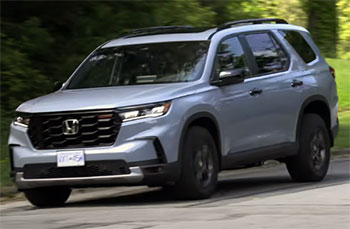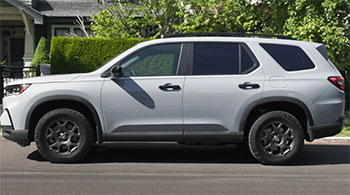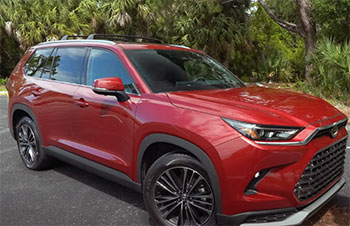As a busy parent managing school drop-offs, weekend soccer games, and cross-country road trips, I needed a three-row SUV that could handle it all. The 2025 Honda Pilot and Toyota Grand Highlander stood out as top contenders in the midsize SUV market, promising space, reliability, and family-friendly features.
In this article, I’ll share my firsthand experience testing these vehicles, comparing their strengths and weaknesses to help you decide which one suits your lifestyle. From performance to tech, cargo space to safety, I’ll cover it all with a detailed comparison table, in-depth pros and cons, and answers to common questions.
Comparison Table: Honda Pilot Vs. Toyota Grand Highlander
| Feature | Honda Pilot (2025) | Toyota Grand Highlander (2025) |
|---|---|---|
| Base Price | ~$40,000 (LX trim) | ~$43,000 (LE trim) |
| Engine Options | 3.5L V6 (285 hp, 262 lb-ft) | 2.4L Turbo I4 (265 hp, 310 lb-ft), Hybrid (362 hp, 400 lb-ft) |
| Fuel Economy (City/Hwy) | 19/27 mpg (FWD), 19/25 mpg (AWD) | 21/28 mpg (Gas), 36/32 mpg (Hybrid) |
| Cargo Space (Behind 3rd/2nd/1st Row) | 18.6-22.4/48.5-60.1/86.5-113.7 cu ft | 20.6/57.9/97.5 cu ft |
| Third-Row Legroom | 32.5 inches | 33.5 inches |
| Seating Capacity | Up to 8 | Up to 8 (7 with captain’s chairs) |
| Infotainment Screen | 7-inch (base), 9-inch (higher trims) | 12.3-inch (all trims) |
| Safety Features | Honda Sensing (standard) | Toyota Safety Sense 3.0 (standard) |
| Towing Capacity | 5,000 lbs (with towing package) | 5,000 lbs (with towing package) |
| Reliability (J.D. Power) | 80/100 | 81/100 (Highlander data) |
My Experience With the Honda Pilot

The 2025 Honda Pilot felt like a trusty companion from the moment I slid behind the wheel.
Its boxy, rugged design exuded confidence, like it was ready for anything—be it a muddy trail or a crowded school pickup line.
The cabin was a haven of practicality, with clever features like a removable second-row seat that stowed under the cargo floor, making it easy to switch between seating for eight or extra cargo space.
The 3.5-liter V6 engine delivered smooth, dependable power, though it wasn’t the most exciting.
Active Noise Cancellation kept the cabin quiet, a blessing during long drives with my talkative kids.
I tested the TrailSport trim, which added off-road flair with all-terrain tires and 8.7 inches of ground clearance.
It handled gravel roads to our favorite campsite with ease, though I wouldn’t take it rock-crawling. The Honda Sensing safety suite, standard across trims, gave me confidence with features like adaptive cruise control and lane-keeping assist.
However, the infotainment system—starting with a 7-inch screen and maxing out at 9 inches—felt dated compared to competitors. Still, the Pilot’s versatility, with up to 113.7 cubic feet of cargo space and 14 cupholders (eight for 32-ounce bottles), made it a family workhorse.
Driving Dynamics
The Pilot’s ride quality was a highlight. Its suspension soaked up potholes and speed bumps without feeling mushy, striking a balance between comfort and control. On highways, it cruised effortlessly, and the 10-speed automatic transmission shifted smoothly, though I noticed a slight hesitation when I floored it to merge. The V6’s 285 horsepower was adequate for most scenarios, but it took 7.2 seconds to reach 60 mph, which felt sluggish compared to turbocharged rivals. Steering was light and predictable, perfect for parking lots, but it lacked the feedback I craved on winding roads. The TrailSport’s all-wheel-drive system and off-road tuned shocks gave it an edge on loose surfaces, making it a great pick for families who venture beyond pavement occasionally.
Interior Comfort and Tech

Inside, the Pilot felt like a practical sanctuary.
The seats were supportive, with enough cushioning for long drives, and the second-row bench offered flexibility with its stowable middle seat.
I loved how easy it was to reconfigure the cabin—perfect for juggling car seats and cargo.
The third row, with 32.5 inches of legroom, was tight for adults but fine for kids or short trips.
Storage was a strong suit, with deep door pockets and a massive center console. The infotainment, however, was a weak point.
The 7-inch base screen looked tiny, and even the 9-inch upgrade felt clunky compared to modern systems.
Only one USB-C port (the rest were USB-A) frustrated my teens, who wanted faster charging. Still, wireless Apple CarPlay and Android Auto worked seamlessly, and the standard 7-speaker audio was crisp.
Value for Money
Starting at around $40,000, the Pilot LX offers a lot for the price: a V6 engine, Honda Sensing, and seating for eight. It’s a solid deal compared to pricier competitors, but the value wanes on higher trims. The Elite, at over $52,000, lacks premium touches like ventilated seats or a panoramic roof, which you’ll find in rivals at similar prices. The TrailSport ($48,000) adds unique off-road features, but its tech feels outdated. For families on a budget, the LX or Sport trims deliver the essentials without breaking the bank, and Honda’s strong resale value is a bonus.
Pros Of the Honda Pilot
- Spacious interior: With 32.5 inches of third-row legroom and up to 113.7 cubic feet of cargo space, the Pilot easily swallowed strollers, sports gear, and suitcases. The removable second-row seat is a genius feature, letting you switch between a bench and captain’s chairs effortlessly.
- Smooth V6 engine: The 3.5-liter V6’s 285 horsepower handles highway merges and towing (up to 5,000 pounds) with ease. Paired with a 10-speed automatic, it’s refined, if not thrilling.
- Quiet cabin: Active Noise Cancellation and available acoustic glass made the Pilot a peaceful retreat, even with kids arguing in the back or on noisy highways.
- Flexible seating: Stowing the second-row middle seat under the cargo floor is a clever solution for families needing versatility. It’s less hassle than removing minivan seats.
- Comprehensive safety suite: Honda Sensing’s adaptive cruise control, lane-keeping assist, and collision mitigation braking come standard, earning the Pilot an IIHS “Top Safety Pick” rating.
- Off-road capability: The TrailSport’s all-terrain tires and 8.7 inches of ground clearance make it surprisingly adept for light off-roading, like gravel paths to campsites.
- Abundant storage: With 14 cupholders and a cavernous center console, the Pilot keeps everyone’s essentials within reach, a lifesaver on long trips.
Read More: My Thoughts On Acura MDX Vs. Lexus GX
Cons Of the Honda Pilot
- Outdated infotainment: The 7-inch base touchscreen feels like a relic, and the 9-inch upgrade doesn’t compete with rivals’ larger displays. Limited USB-C ports (one versus multiple USB-A) annoyed my tech-dependent kids.
- Sluggish acceleration: The V6’s 7.2-second 0-60 mph time feels slow, especially when merging onto busy highways. Throttle response can be laggy.
- Uninspiring steering: The steering is light but lacks feedback, making the Pilot feel disconnected on curvy roads, though it’s fine for daily driving.
- Price creep on higher trims: The base LX is a bargain at $40,000, but the Elite’s $52,000+ price tag feels steep without premium features like ventilated seats.
- Third-row access: Climbing into the third row is tricky, especially with car seats installed. The sliding second row helps, but it’s not seamless.
- Fuel economy: At 19/27 mpg (FWD), the Pilot lags behind hybrid competitors, which could strain gas budgets on long family trips.
- No hybrid option: Unlike the Grand Highlander, the Pilot lacks a hybrid powertrain, limiting its appeal for eco-conscious buyers.
My Experience With the Toyota Grand Highlander

The 2025 Toyota Grand Highlander felt like a breath of fresh air with its sleek design and modern interior.
It’s essentially a stretched Highlander with a tech-heavy focus, and it showed.
The standard 12.3-inch touchscreen was a standout, offering crisp graphics and an intuitive interface that made navigation a breeze.
I tested both the 2.4-liter turbo gas engine and the Hybrid Max, and the latter’s 362 horsepower was a revelation—quick, smooth, and perfect for zipping past slow traffic.
The ride was comfortable, though it leaned more in corners than the Pilot, and the cabin stayed quiet enough for my kids to nap.
The interior blended practicality with a touch of luxury.
The open bridge console offered clever storage for phones and snacks, and the second-row captain’s chairs made third-row access a cinch. With 20.6 cubic feet behind the third row and 97.5 cubic feet total, it handled most of my family’s gear, though it didn’t match the Pilot’s max cargo capacity. Toyota Safety Sense 3.0, with features like lane-tracing assist and pre-collision braking, felt polished and reliable.
My biggest gripe? The toggle-style shifter was confusing, often leaving me fumbling between gears. Still, the Grand Highlander’s tech and efficiency made it a strong contender.
Driving Dynamics
The Grand Highlander’s driving experience varied by powertrain. The standard 2.4-liter turbo-four (265 hp, 310 lb-ft) was torquey but noisy under hard acceleration, taking about 7 seconds to hit 60 mph. The Hybrid Max, however, was a game-changer, with 362 horsepower and a 6.3-second 0-60 sprint that felt sporty for a family SUV. Both powertrains paired with an 8-speed automatic, which shifted smoothly but occasionally hunted for gears. The suspension prioritized comfort, soaking up bumps well but allowing more body roll than the Pilot in corners. Steering was precise but, like the Pilot, lacked feedback. The AWD system and multi-terrain modes handled light trails, but it’s no off-roader.
Interior Comfort and Tech
The Grand Highlander’s cabin felt upscale, with soft-touch materials and a modern layout. The second-row captain’s chairs were a hit, offering a wide aisle to the third row, which had 33.5 inches of legroom—enough for adults on short trips. The bridge console, removable cupholder, and dash storage drawer were genius for keeping clutter at bay. The 12.3-inch touchscreen stole the show, with wireless Apple CarPlay, Android Auto, and a responsive interface. Multiple USB-C ports kept everyone’s devices charged, and the available 11-speaker JBL audio system was a treat for music lovers. My only complaint was the lack of a panoramic roof on lower trims, which would’ve brightened the cabin.
Value for Money
At $43,000, the Grand Highlander LE is pricier than the Pilot LX, but the standard 12.3-inch screen and Toyota Safety Sense 3.0 justify the cost. The Hybrid Max ($50,000+) offers unmatched power and 36 mpg combined, a rare combo in this class. However, fully loaded trims like the Platinum ($55,000) miss some luxury features, like a panoramic roof, found in competitors. The hybrid’s fuel savings and Toyota’s stellar resale value make it a smart long-term investment, especially for families prioritizing efficiency. The base gas model, while less efficient, still offers strong value with its tech and space.
Pros Of the Toyota Grand Highlander
- Powerful hybrid option: The Hybrid Max’s 362 horsepower and 400 lb-ft of torque make it quick and fun, ideal for towing (5,000 pounds) or highway passing.
- Impressive fuel economy: The hybrid’s 36 mpg combined is a standout, and even the gas model’s 21/28 mpg beats the Pilot, saving money at the pump.
- Large touchscreen: The 12.3-inch standard touchscreen is crisp and user-friendly, with wireless Apple CarPlay and Android Auto, outshining the Pilot’s tech.
- Clever storage solutions: The bridge console, removable cupholder, and dash drawer make organizing essentials easy, keeping the cabin clutter-free.
- Spacious third row: With 33.5 inches of legroom, the third row fits adults better than the Pilot’s, and captain’s chairs simplify access.
- Advanced safety features: Toyota Safety Sense 3.0 includes lane-tracing assist, pre-collision braking, and a five-star NHTSA rating for peace of mind.
- Premium interior: Soft-touch materials and a modern layout give the cabin a near-luxury feel, especially in higher trims with the JBL audio system.
Cons Of the Toyota Grand Highlander
- Confusing shifter: The toggle-style shifter was unintuitive, making gear changes awkward and frustrating, especially in tight parking lots.
- Less cargo space: With 97.5 cubic feet max, it falls short of the Pilot’s 113.7 cubic feet, limiting space for big family hauls.
- Higher starting price: The $43,000 base price is steeper than the Pilot’s, and loaded trims near $55,000 lack some premium features.
- Mushy handling: The Grand Highlander leans more in corners than the Pilot, feeling less planted on curvy roads despite a comfortable ride.
- Noisy base engine: The 2.4-liter turbo-four gets loud during hard acceleration, disrupting the cabin’s calm compared to the Pilot’s V6.
- Limited off-road capability: The AWD and multi-terrain modes are fine for light trails but can’t match the Pilot TrailSport’s off-road prowess.
- No panoramic roof on lower trims: Unlike some rivals, lower trims miss out on a panoramic roof, which would’ve enhanced the cabin’s airy feel.
Read More: My Thoughts On Acura MDX Vs. Jeep Grand Cherokee
Frequently Asked Questions (FAQ)
The Toyota Highlander edges out the Honda Pilot with a J.D. Power reliability score of 81/100 compared to the Pilot’s 80/100. Both are dependable, but Toyota’s track record gives it a slight advantage.
The Honda Pilot is the closest equivalent to the Toyota Highlander, as both are midsize, three-row SUVs designed for families, with similar pricing and features. The Grand Highlander is a larger, more direct competitor to the Pilot.
Yes, the 2025 Honda Pilot is wider at 78.6 inches compared to the Toyota Highlander’s 76 inches. The Grand Highlander, however, is closer at 78.3 inches wide.
The Toyota Grand Highlander competes with the Honda Pilot, Kia Telluride, Hyundai Palisade, Mazda CX-90, and Jeep Grand Cherokee L in the midsize three-row SUV segment.
Conclusion: For the Honda Pilot and Toyota Grand Highlander
After spending time with the 2025 Honda Pilot and Toyota Grand Highlander, I’m convinced both are fantastic family SUVs, but your choice hinges on your priorities. The Pilot is your go-to if you need maximum cargo space, flexible seating, and off-road capability. Its smooth V6, quiet cabin, and practical design make it a dependable workhorse, though its dated tech and average fuel economy might frustrate. The Grand Highlander shines if you want a powerful hybrid, top-notch tech, and a roomier third row. Its large touchscreen and fuel efficiency are hard to beat, but the quirky shifter and higher price could be drawbacks. Take both for a spin to see which feels right for your family’s needs.

